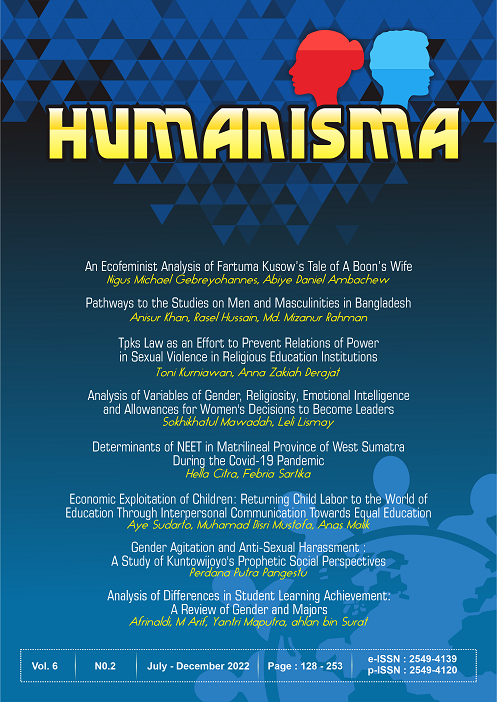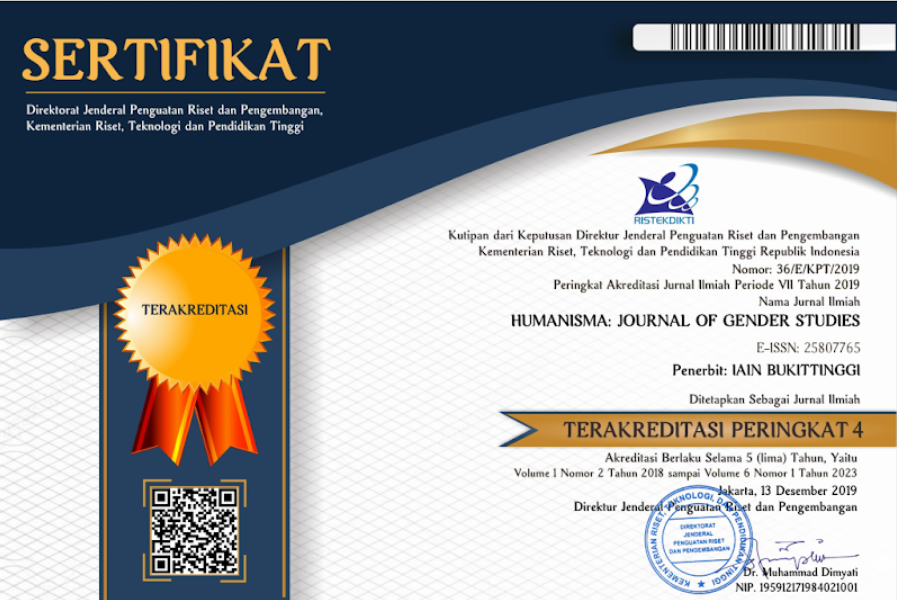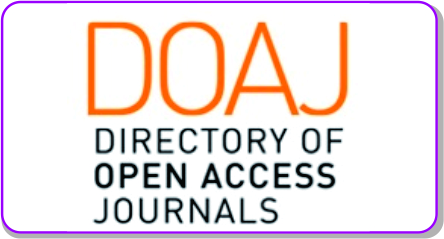Determinants of NEET in Matrilineal Province of West Sumatra During the Covid-19 Pandemic
DOI:
https://doi.org/10.30983/humanisme.v6i2.5928Keywords:
Education, NEET, Logistic Regression, Youth,Abstract
NEET (Not in Education, Employment, or Training)is one of the Sustainable Development Goals (SDGs) indicators used to assess the level of vulnerability of the young population aged 15-24 in terms of unemployment, school dropout, and labor-market despair. According to BPS data, 195,380 people in West Sumatra Province (20.5 percent) became NEET in 2020. Nationally, West Sumatra's NEET rate is ranked the 13th highest. This study aims to determine the general description and determinants that cause a person to have the opportunity to become a NEET in West Sumatra using Sakernas data in 2020. The analysis method used is descriptive statistics and inferential statistics with a binary logistic regression model. The results showed that, with a 99 percent confidence level, the variables that significantly affect a person's status as NEET are age, disability, marital status, education, skills, work experience, education of the head of the household, number of children, presence of toddlers or elderly, presence of working household members, and the perceived impact of COVID-19. People with disabilities are six times more at risk of becoming NEET than those without disabilities. Meanwhile, gender status and location of residence do not affect a person's status as a NEET. In contrast to other provinces where women are more likely to become NEET, West Sumatera's unique matrilineal system means that gender has no bearing on a person's NEET status.
References
Journal
Abrar, Muhammad, Nuelda Amalia, dan Rossanto Dwi Handoyo, “Karakteristik dan peluang pengangguran usia muda di Provinsi Aceh dalam menghadapi era Revolusi Industri 4.0 [Characteristics and opportunities for young unemployed in Aceh Province in the face of the Industrial Revolution 4.0 era],†Jurnal Kebijakan Pembangunan, 14.2 (2019), 157–69
Ahmad, Rizwan, dan Parvez Azim, “Youth Population and the Labour Market of Pakistan: a Micro Level Study,†Pakistan Economic and Social Review, 48.2 (2010), 183–208
Albert Dagume, Mbulaheni, dan Agyapong Gyekye, “Determinants of youth unemployment in South Africa: evidence from the Vhembe district of Limpopo province,†Environmental Economics, 7.4 (2016), 59–67 <https://doi.org/10.21511/ee.07(4).2016.06>
Alfieri, Sara, Emiliano Sironi, Elena Marta, Alessandro Rosina, dan Daniela Marzana, “Young italian NEETs (Not in employment, education, or training) and the influence of their family background,†Europe’s Journal of Psychology, 11.2 (2015), 311–22 <https://doi.org/10.5964/ejop.v11i2.901>
Bay, Ann-Helén, dan Morten Blekesaune, “Youth, unemployment and political marginalisation,†International Journal of Social Welfare, 11.2 (2002), 132–39 <https://doi.org/10.1111/1468-2397.00207>
Chintia Anggraini, Werry Darta Taifur, dan Zulkifli N, “Phenomenon and determinant characteristics of NEET (Not in Employment, Education or Training) youth in matrilineal province,†Jurnal Perspektif Pembiayaan dan Pembangunan Daerah, 7.4 (2020), 327–40 <https://doi.org/10.22437/ppd.v7i4.8690>
Hasanah, Putri Uswatun, “Pengaruh program keluarga berencana terhadap pemenuhan kebutuhan pendidikan anak,†Lembaran Masyarakat: Jurnal Pengembangan Masyarakat Islam, 1.2 (2015), 191–220
Lee Byoung-Hoon, dan Kim Jong-Sung, “A Causal Analysis of Youth Inactiveness in the Korean Labor Market,†Korea Journal, 52.4 (2012), 139–65 <https://doi.org/10.25024/kj.2012.52.4.139>
Pattinasarany, Indera Ratna Irawati, “Not in Employment, Education or Training (NEET) Among the Youth in Indonesia: The Effects of Social Activities, Access to Information, and Language Skills on NEET Youth,†MASYARAKAT: Jurnal Sosiologi, 24.1 (2019), 1–25 <https://doi.org/10.7454/mjs.v24i1.10308>
Susanli, Z. Bilgen, “Understanding the Neet in Turkey,†Eurasian Journal of Economics and Finance, 4.2 (2016), 42–57 <https://doi.org/10.15604/ejef.2016.04.02.004>
Susiana, Wardah, “Pemenuhan Hak Penyandang Disabilitas dalam Mendapatkan Pekerjaan di BUMN,†Law Reform, 15.2 (2019), 225–38 <https://doi.org/10.14710/lr.v15i2.26181>
Syahrial, “Dampak Covid-19 terhadap Tenaga Kerja,†Ners, 4.23 (2020), 21–29
Wardhana, Adhitya, Bayu Kharisma, dan Yayuf Faridah Ibrahim, “Pengangguran Usia Muda di Jawa Barat (Menggunakan Data Sakernas),†E-Jurnal Ekonomi dan Bisnis Universitas Udayana, 9.8 (2019), 1049–62
Zoraya, Elfrida, dan Mirta Dwi Wulandari, “Karakteristik Kaum Muda Pada Pasar Tenaga Kerja Dan Determinan Neet Di Indonesia,†Jurnal Litbang Sukowati : Media Penelitian dan Pengembangan, 4.2 (2020), 12 <https://doi.org/10.32630/sukowati.v4i2.144>
Books
Badan Pusat Statistik, “Hasil Sensus Penduduk 2020,†2021 <https://www.bps.go.id/pressrelease/2021/01/21/1854/hasil-sensus-penduduk-2020.html> [diakses 3 September 2021]
———, “Indikator dan Konsep yang Digunakan Survei Angkatan Kerja Nasional (SAKERNAS), 2020,†2021 <https://sirusa.bps.go.id/sirusa/index.php/dasar/view?kd=5&th=2020> [diakses 3 September 2021]
———, Indikator Pasar Tenaga Kerja Indonesia Agustus 2020 (Jakarta: Badan Pusat Statistik, 2021)
———, “Persentase Umur Muda 15-24 Tahun yang sedang Tidak Sekolah, Bekerja atau Mengikuti Pelatihan, 2015-2020,†2021 <https://www.bps.go.id/indicator/6/1186/1/persentase-umur-muda-15-24-tahun-yang-sedang-tidak-sekolah-bekerja-atau-mengikuti-pelatihan.html> [diakses 3 September 2021]
———, “Tingkat Pengangguran Terbuka Berdasarkan Kelompok Umur, 2015-2020,†2020 <https://www.bps.go.id/indicator/6/1180/1/tingkat-pengangguran-terbuka-berdasarkan-kelompok-umur.html>
Bappenas, Bonus Demografi 2030-2040: Strategi Indonesia Terkait Ketenagakerjaan dan Pendidikan. (Jakarta: Bappenas, 2017)
BPS Provinsi Sumatera Barat, “Jumlah Penduduk Usia Kerja yang Terdampak Covid-10 menurut Kabupaten/Kota (orang),†2020
———, Keadaan Ketenagakerjaan Indonesia Agustus 2020 (Padang: BPS Provinsi Sumatera Barat, 2021)
Nachrowi, Nachrowi Dlalal, dan Hardius Usman, Penggunaan Teknik Ekonometri, Pendekatan Populer & Praktis Dilengkapi Teknik Analisis & Pengolahan Data dengan Menggunakan Paket Program SPSS. (Jakarta: Raja Grafindo, 2002)
Others
Amini, Ary Fauziah, “Analisis Karakteristik Penduduk Usia Muda Tidak Bekerja, Sekolah, Atau Mengikuti Pelatihan (Not In Employment, Education Or Training/Neet) Tahun 2018†(UNIVERSITAS AIRLANGGA, 2020)
Elder, S, “What does NEETs mean and why is the concept so easily misinterpreted?,†ILO. Technical brief, 1.1 (2015)
Downloads
Submitted
Accepted
Published
Issue
Section
License
Authors who publish with this journal agree to the following terms:
- Authors retain copyright and grant the journal right of first publication with the work simultaneously licensed under a Creative Commons Attribution-ShareAlike 4.0. that allows others to share the work with an acknowledgment of the work's authorship and initial publication in this journal.
- Authors are able to enter into separate, additional contractual arrangements for the non-exclusive distribution of the journal's published version of the work (e.g., post it to an institutional repository or publish it in a book), with an acknowledgment of its initial publication in this journal.
- Authors are permitted and encouraged to post their work online (e.g., in institutional repositories or on their website) prior to and during the submission process, as it can lead to productive exchanges, as well as earlier and greater citation of published work (See The Effect of Open Access).



















